GSBS6002: Analyzing the Effectiveness of Bank A's Online Security
VerifiedAdded on 2023/04/17
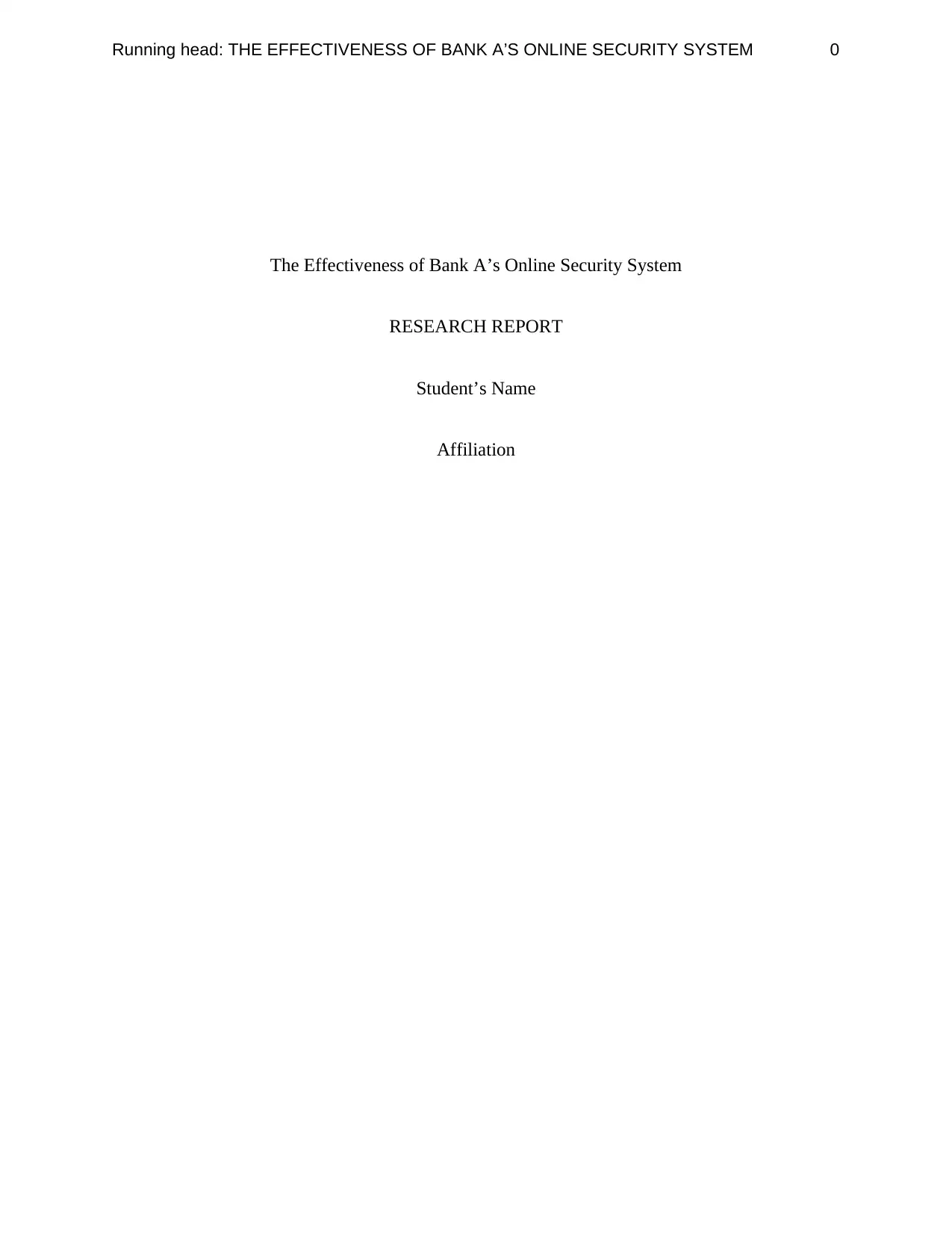
The Effectiveness of Bank A’s Online Security System
RESEARCH REPORT
Student’s Name
Affiliation
Paraphrase This Document
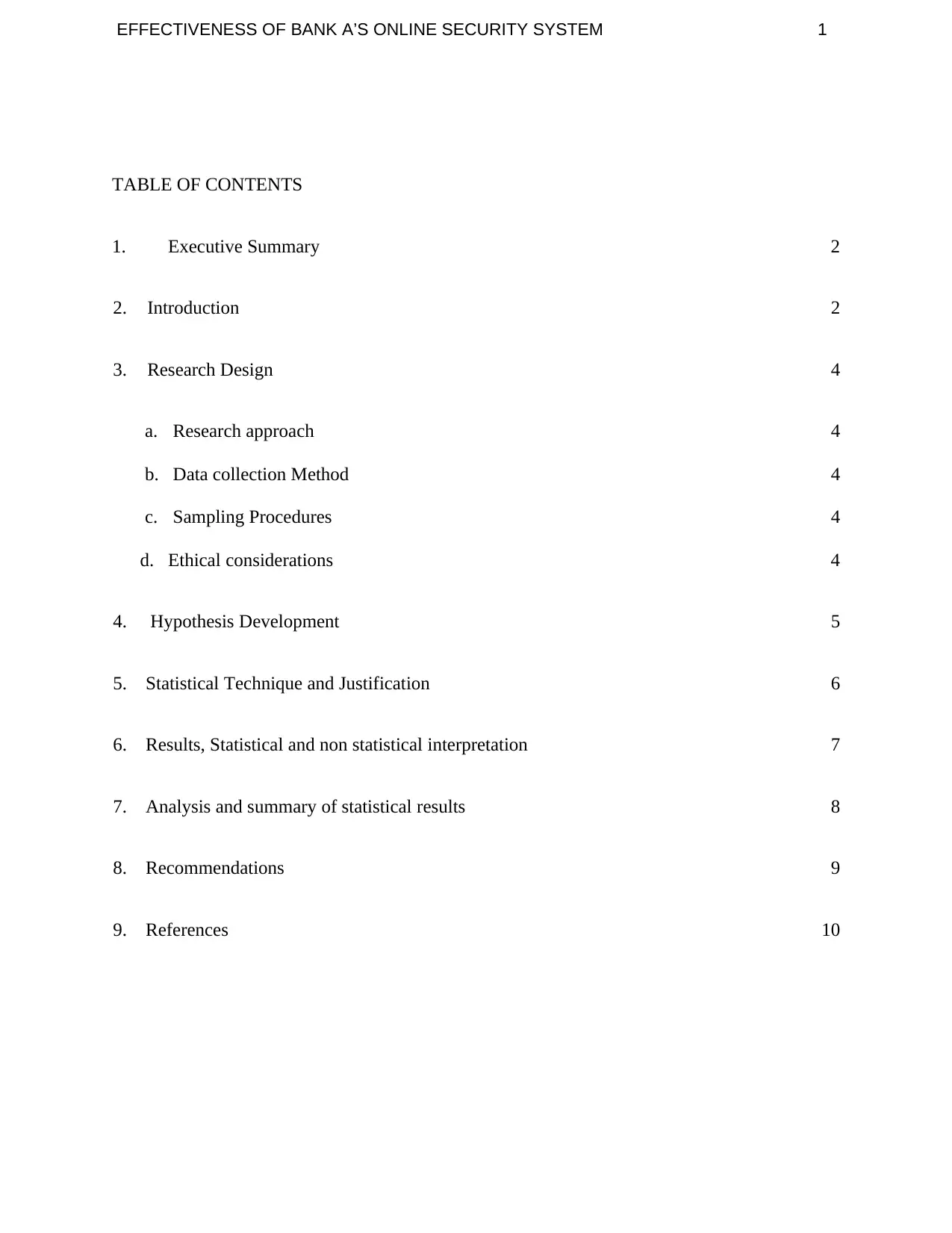
TABLE OF CONTENTS
1. Executive Summary 2
2. Introduction 2
3. Research Design 4
a. Research approach 4
b. Data collection Method 4
c. Sampling Procedures 4
d. Ethical considerations 4
4. Hypothesis Development 5
5. Statistical Technique and Justification 6
6. Results, Statistical and non statistical interpretation 7
7. Analysis and summary of statistical results 8
8. Recommendations 9
9. References 10
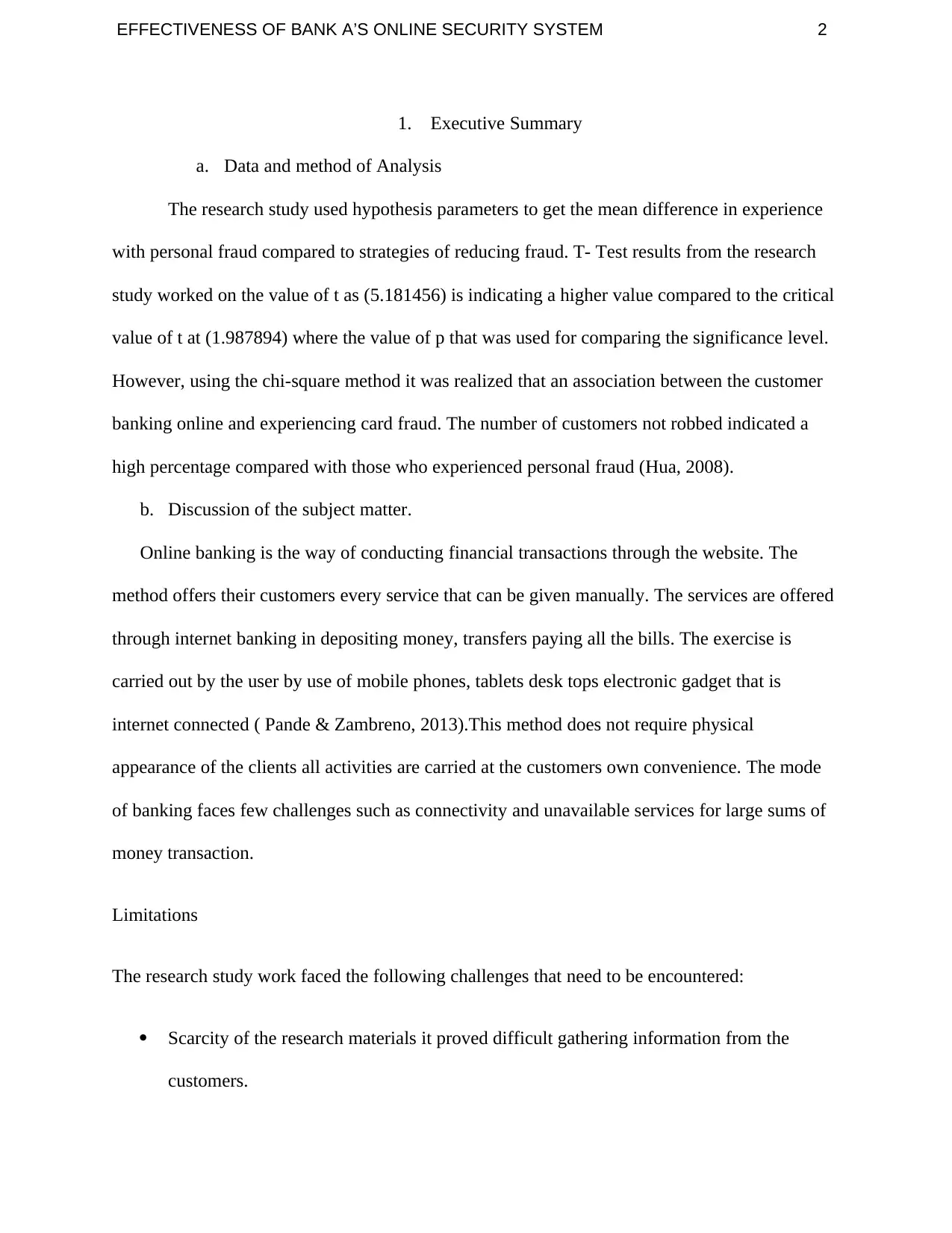
1. Executive Summary
a. Data and method of Analysis
The research study used hypothesis parameters to get the mean difference in experience
with personal fraud compared to strategies of reducing fraud. T- Test results from the research
study worked on the value of t as (5.181456) is indicating a higher value compared to the critical
value of t at (1.987894) where the value of p that was used for comparing the significance level.
However, using the chi-square method it was realized that an association between the customer
banking online and experiencing card fraud. The number of customers not robbed indicated a
high percentage compared with those who experienced personal fraud (Hua, 2008).
b. Discussion of the subject matter.
Online banking is the way of conducting financial transactions through the website. The
method offers their customers every service that can be given manually. The services are offered
through internet banking in depositing money, transfers paying all the bills. The exercise is
carried out by the user by use of mobile phones, tablets desk tops electronic gadget that is
internet connected ( Pande & Zambreno, 2013).This method does not require physical
appearance of the clients all activities are carried at the customers own convenience. The mode
of banking faces few challenges such as connectivity and unavailable services for large sums of
money transaction.
Limitations
The research study work faced the following challenges that need to be encountered:
Scarcity of the research materials it proved difficult gathering information from the
customers.
⊘ This is a preview!⊘
Do you want full access?
Subscribe today to unlock all pages.

Trusted by 1+ million students worldwide
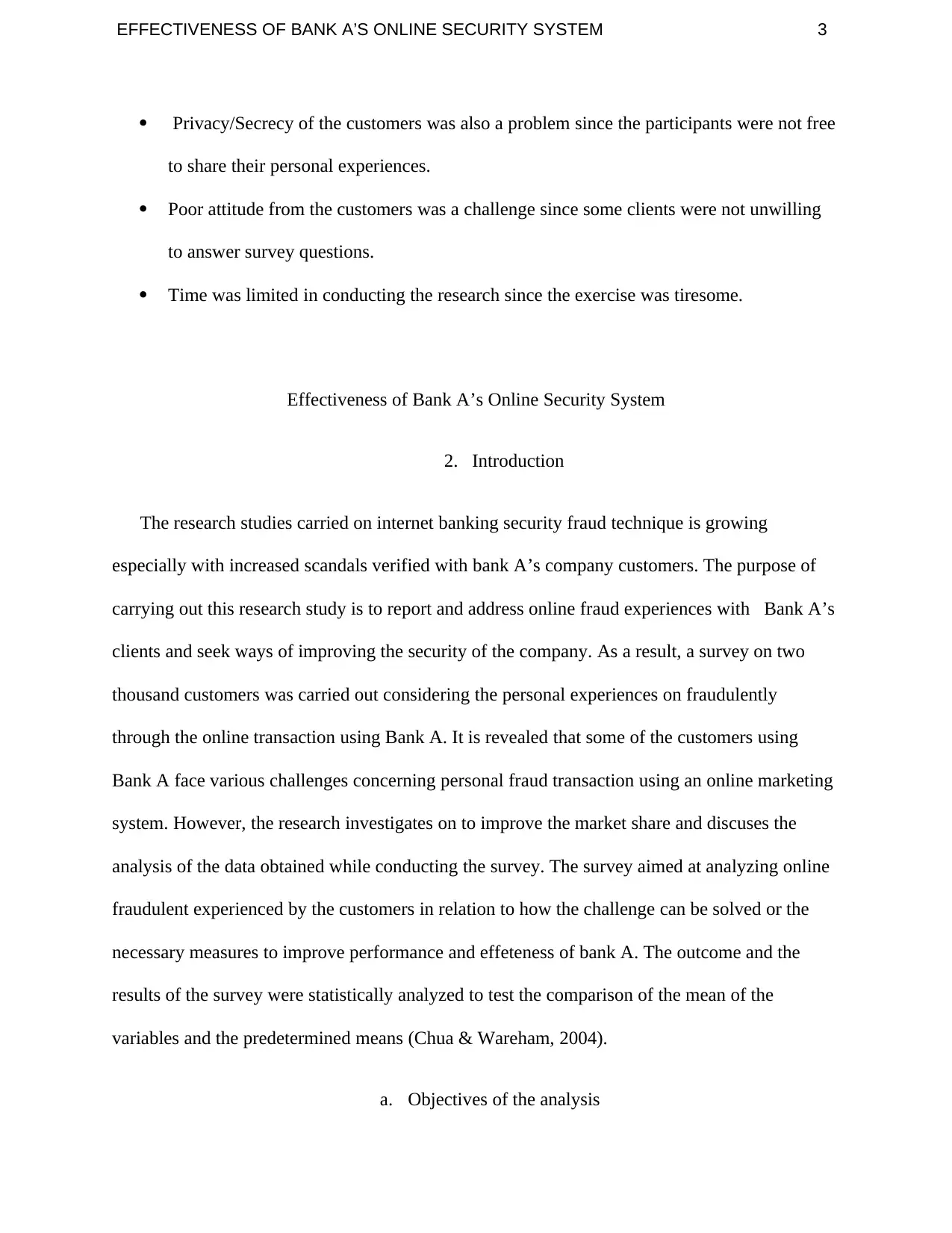
Privacy/Secrecy of the customers was also a problem since the participants were not free
to share their personal experiences.
Poor attitude from the customers was a challenge since some clients were not unwilling
to answer survey questions.
Time was limited in conducting the research since the exercise was tiresome.
Effectiveness of Bank A’s Online Security System
2. Introduction
The research studies carried on internet banking security fraud technique is growing
especially with increased scandals verified with bank A’s company customers. The purpose of
carrying out this research study is to report and address online fraud experiences with Bank A’s
clients and seek ways of improving the security of the company. As a result, a survey on two
thousand customers was carried out considering the personal experiences on fraudulently
through the online transaction using Bank A. It is revealed that some of the customers using
Bank A face various challenges concerning personal fraud transaction using an online marketing
system. However, the research investigates on to improve the market share and discuses the
analysis of the data obtained while conducting the survey. The survey aimed at analyzing online
fraudulent experienced by the customers in relation to how the challenge can be solved or the
necessary measures to improve performance and effeteness of bank A. The outcome and the
results of the survey were statistically analyzed to test the comparison of the mean of the
variables and the predetermined means (Chua & Wareham, 2004).
a. Objectives of the analysis
Paraphrase This Document

To determine internet banking customer’s behavior concerning online transactions and kind
of experience perceived using money line banking or the risks they incur. To determine the
sources and causes of internet bank thefts with bank A. Necessary measures to be put in place for
implementation in order to prevent online bank theft. (Duignan, 2013). To determine the
contributions of technology associated with internet banking and possible risks of IT in the
market. The study will research and determine if there are websites that are secure for online
services and banking. Therefore, it is advisable for the company to find ways of preventing
cooperative fraud bank in the financial institutions for better economic development (Dada,
2007).
Internet banking is highly growing since it provides quick access and saves the company
extra costs that may be incurred in making the transactions. However, it is argued that a third of
the customers surveyed suffered from fraudulent transaction cases. The research conducted
showed that there is a gradual increase in numbers with those customers who are using online
bank A (DeYoung, 2005). Arguably; we did not have the clients with the same challenges of
online fraudulent using online banking due to a different mode of the transaction such as manual
banking rather than online. Most of the online fraudulent banking happens in through the
customer’s username and password is shared to the third party. Two-thirds of the customers cited
being scammed through the emails sent to their accounts and risky sharing their personal
information in the hands of the fraudulent (Guriting $ Oly 2006).
3. Research Design
c. Research Approach
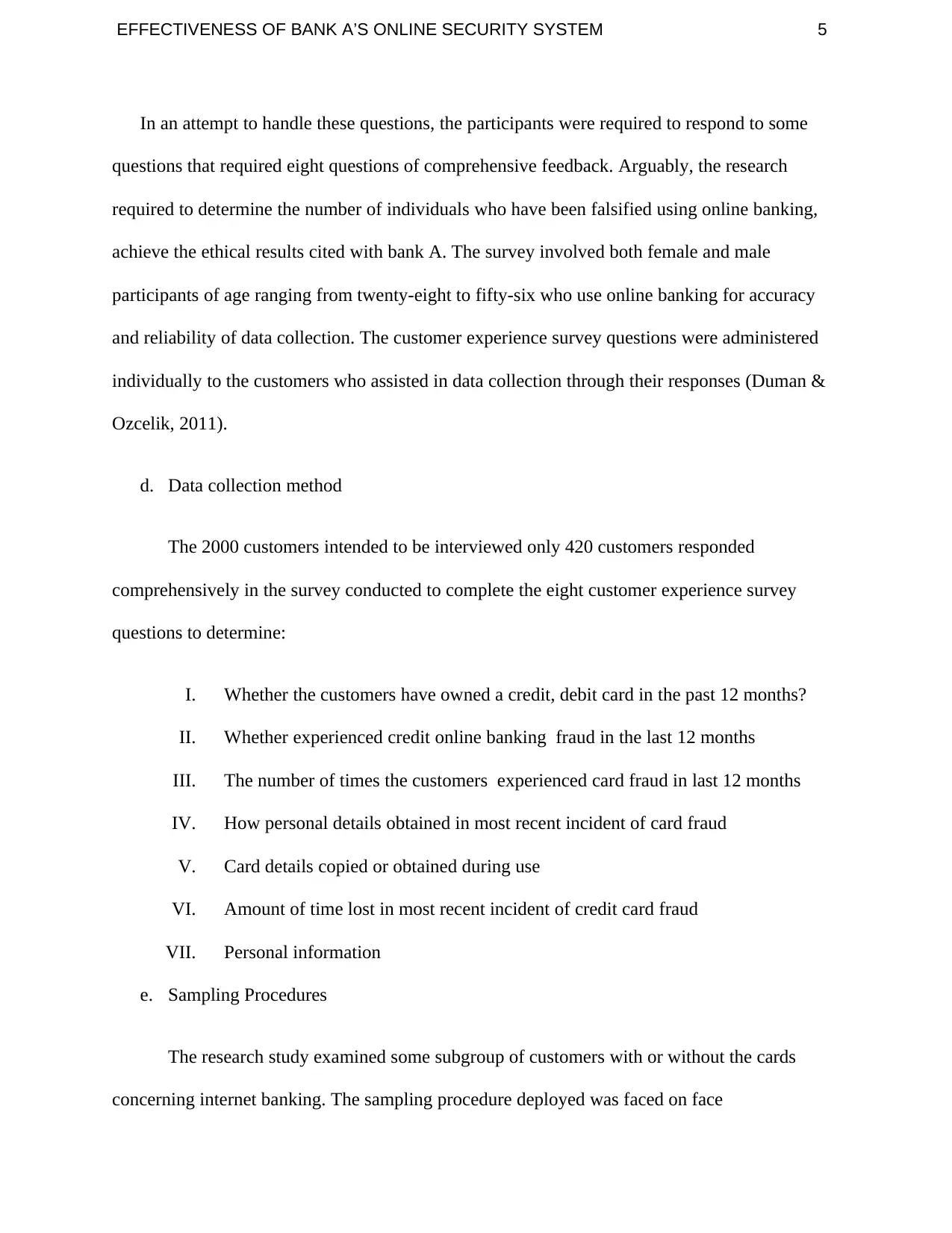
In an attempt to handle these questions, the participants were required to respond to some
questions that required eight questions of comprehensive feedback. Arguably, the research
required to determine the number of individuals who have been falsified using online banking,
achieve the ethical results cited with bank A. The survey involved both female and male
participants of age ranging from twenty-eight to fifty-six who use online banking for accuracy
and reliability of data collection. The customer experience survey questions were administered
individually to the customers who assisted in data collection through their responses (Duman &
Ozcelik, 2011).
d. Data collection method
The 2000 customers intended to be interviewed only 420 customers responded
comprehensively in the survey conducted to complete the eight customer experience survey
questions to determine:
I. Whether the customers have owned a credit, debit card in the past 12 months?
II. Whether experienced credit online banking fraud in the last 12 months
III. The number of times the customers experienced card fraud in last 12 months
IV. How personal details obtained in most recent incident of card fraud
V. Card details copied or obtained during use
VI. Amount of time lost in most recent incident of credit card fraud
VII. Personal information
e. Sampling Procedures
The research study examined some subgroup of customers with or without the cards
concerning internet banking. The sampling procedure deployed was faced on face
⊘ This is a preview!⊘
Do you want full access?
Subscribe today to unlock all pages.

Trusted by 1+ million students worldwide
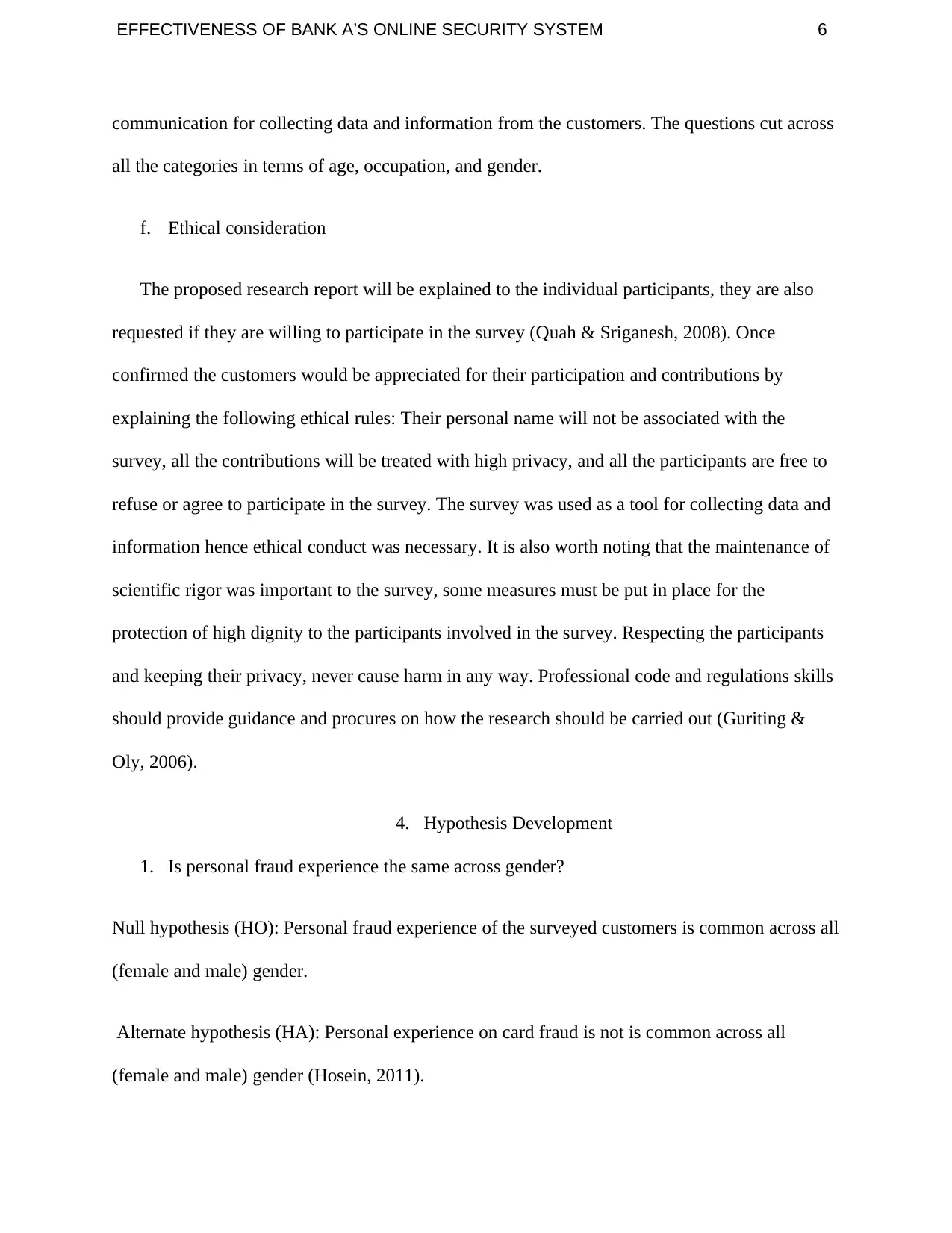
communication for collecting data and information from the customers. The questions cut across
all the categories in terms of age, occupation, and gender.
f. Ethical consideration
The proposed research report will be explained to the individual participants, they are also
requested if they are willing to participate in the survey (Quah & Sriganesh, 2008). Once
confirmed the customers would be appreciated for their participation and contributions by
explaining the following ethical rules: Their personal name will not be associated with the
survey, all the contributions will be treated with high privacy, and all the participants are free to
refuse or agree to participate in the survey. The survey was used as a tool for collecting data and
information hence ethical conduct was necessary. It is also worth noting that the maintenance of
scientific rigor was important to the survey, some measures must be put in place for the
protection of high dignity to the participants involved in the survey. Respecting the participants
and keeping their privacy, never cause harm in any way. Professional code and regulations skills
should provide guidance and procures on how the research should be carried out (Guriting &
Oly, 2006).
4. Hypothesis Development
1. Is personal fraud experience the same across gender?
Null hypothesis (HO): Personal fraud experience of the surveyed customers is common across all
(female and male) gender.
Alternate hypothesis (HA): Personal experience on card fraud is not is common across all
(female and male) gender (Hosein, 2011).
Paraphrase This Document
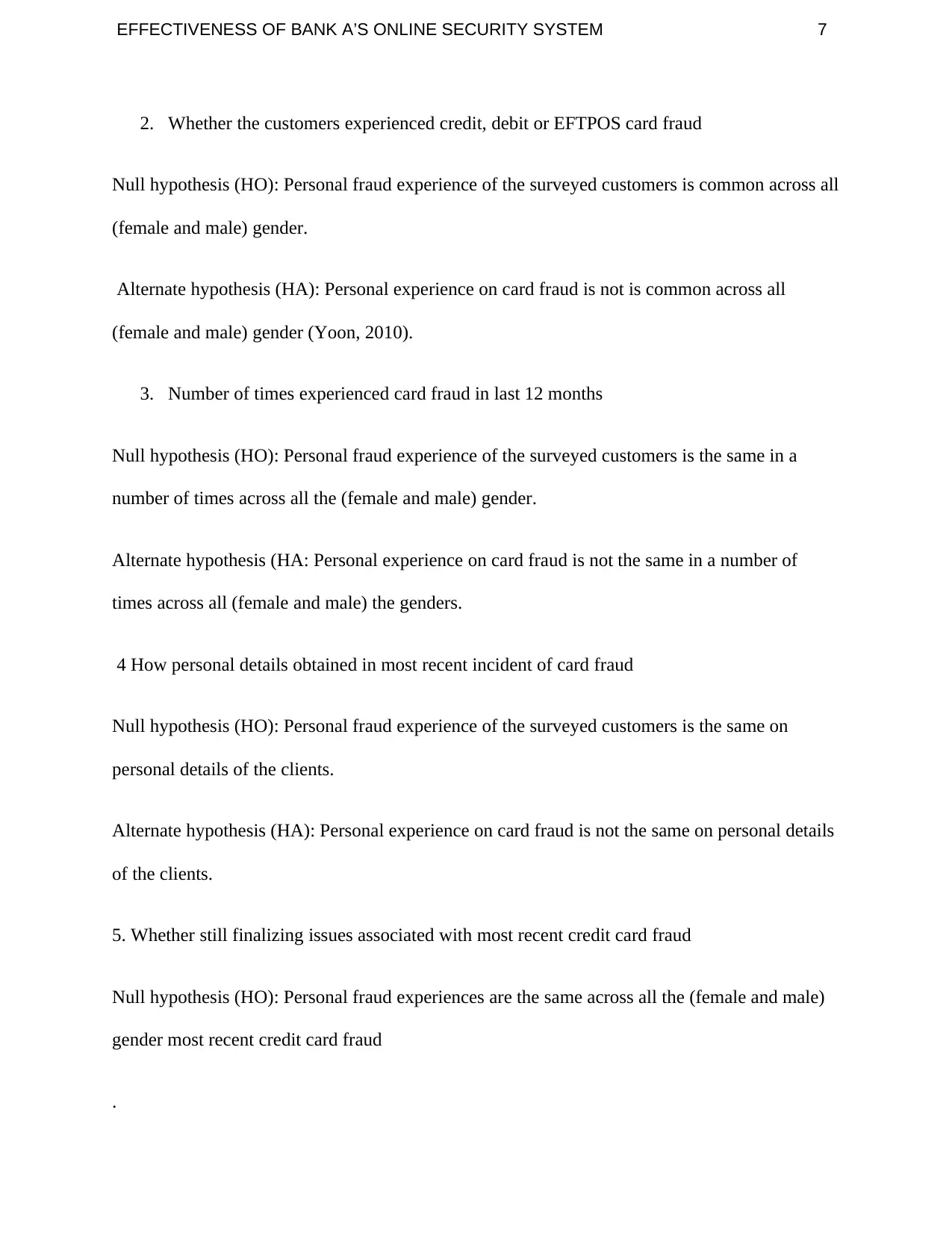
2. Whether the customers experienced credit, debit or EFTPOS card fraud
Null hypothesis (HO): Personal fraud experience of the surveyed customers is common across all
(female and male) gender.
Alternate hypothesis (HA): Personal experience on card fraud is not is common across all
(female and male) gender (Yoon, 2010).
3. Number of times experienced card fraud in last 12 months
Null hypothesis (HO): Personal fraud experience of the surveyed customers is the same in a
number of times across all the (female and male) gender.
Alternate hypothesis (HA: Personal experience on card fraud is not the same in a number of
times across all (female and male) the genders.
4 How personal details obtained in most recent incident of card fraud
Null hypothesis (HO): Personal fraud experience of the surveyed customers is the same on
personal details of the clients.
Alternate hypothesis (HA): Personal experience on card fraud is not the same on personal details
of the clients.
5. Whether still finalizing issues associated with most recent credit card fraud
Null hypothesis (HO): Personal fraud experiences are the same across all the (female and male)
gender most recent credit card fraud
.
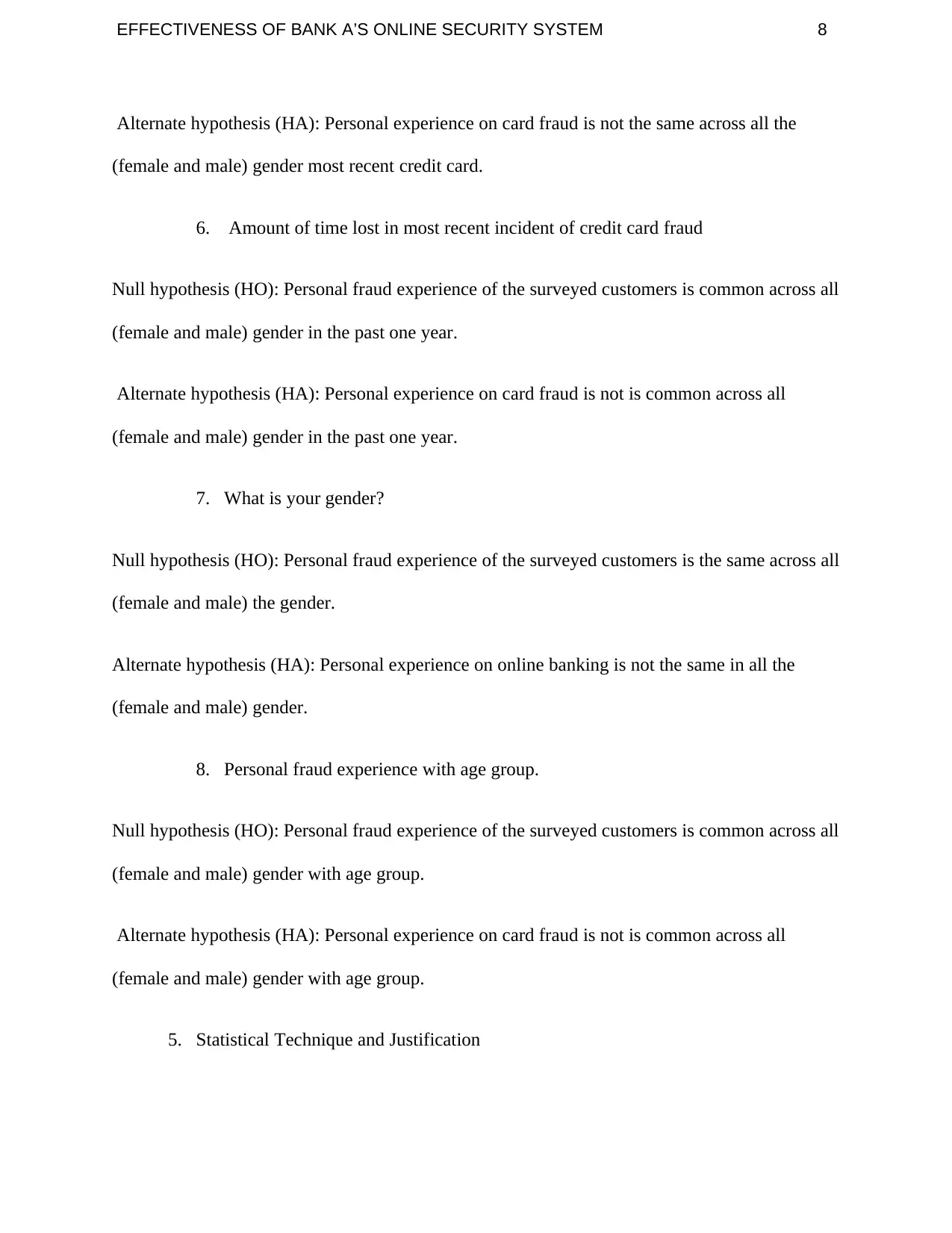
Alternate hypothesis (HA): Personal experience on card fraud is not the same across all the
(female and male) gender most recent credit card.
6. Amount of time lost in most recent incident of credit card fraud
Null hypothesis (HO): Personal fraud experience of the surveyed customers is common across all
(female and male) gender in the past one year.
Alternate hypothesis (HA): Personal experience on card fraud is not is common across all
(female and male) gender in the past one year.
7. What is your gender?
Null hypothesis (HO): Personal fraud experience of the surveyed customers is the same across all
(female and male) the gender.
Alternate hypothesis (HA): Personal experience on online banking is not the same in all the
(female and male) gender.
8. Personal fraud experience with age group.
Null hypothesis (HO): Personal fraud experience of the surveyed customers is common across all
(female and male) gender with age group.
Alternate hypothesis (HA): Personal experience on card fraud is not is common across all
(female and male) gender with age group.
5. Statistical Technique and Justification
⊘ This is a preview!⊘
Do you want full access?
Subscribe today to unlock all pages.

Trusted by 1+ million students worldwide
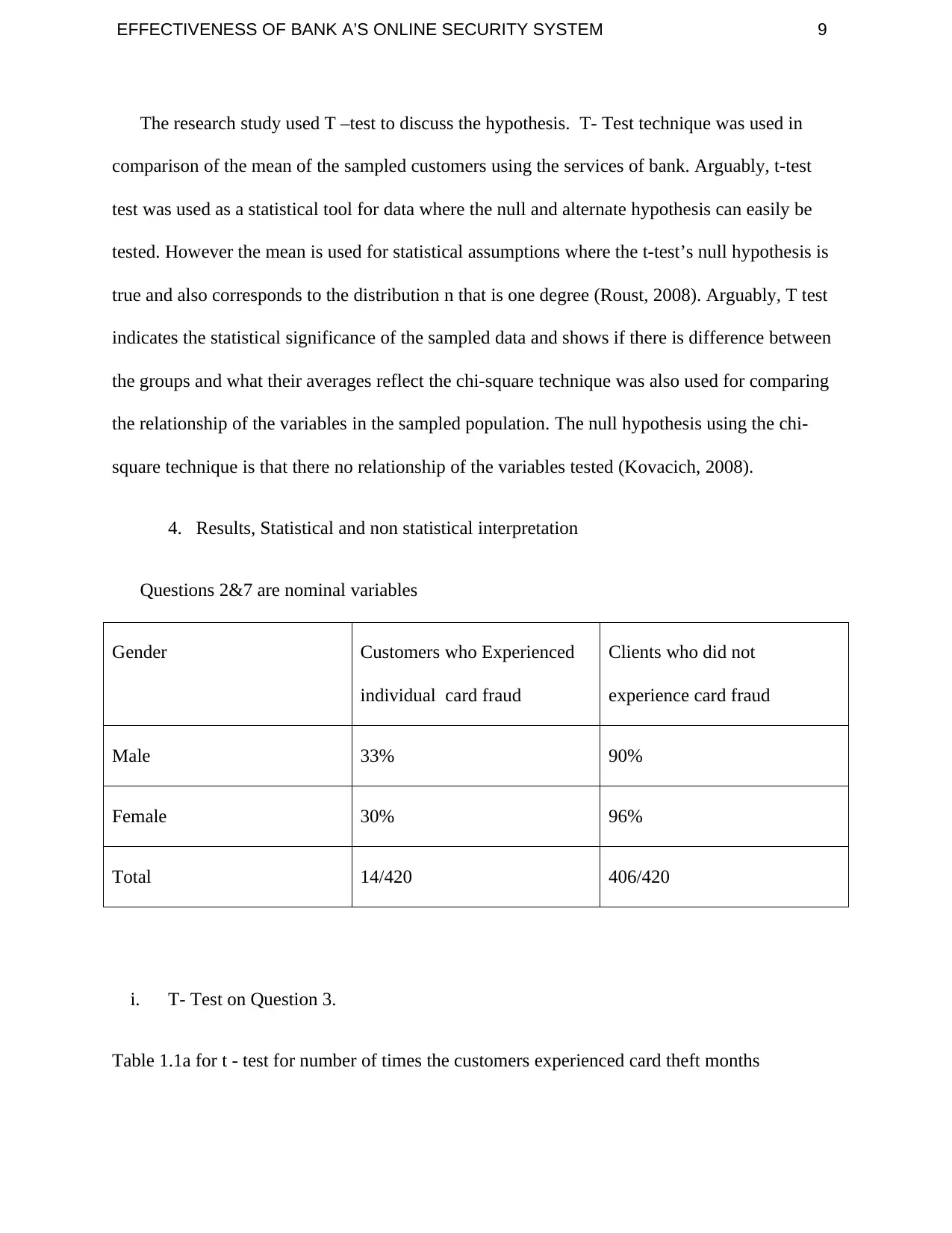
The research study used T –test to discuss the hypothesis. T- Test technique was used in
comparison of the mean of the sampled customers using the services of bank. Arguably, t-test
test was used as a statistical tool for data where the null and alternate hypothesis can easily be
tested. However the mean is used for statistical assumptions where the t-test’s null hypothesis is
true and also corresponds to the distribution n that is one degree (Roust, 2008). Arguably, T test
indicates the statistical significance of the sampled data and shows if there is difference between
the groups and what their averages reflect the chi-square technique was also used for comparing
the relationship of the variables in the sampled population. The null hypothesis using the chi-
square technique is that there no relationship of the variables tested (Kovacich, 2008).
4. Results, Statistical and non statistical interpretation
Questions 2&7 are nominal variables
Gender Customers who Experienced
individual card fraud
Clients who did not
experience card fraud
Male 33% 90%
Female 30% 96%
Total 14/420 406/420
i. T- Test on Question 3.
Table 1.1a for t - test for number of times the customers experienced card theft months
Paraphrase This Document
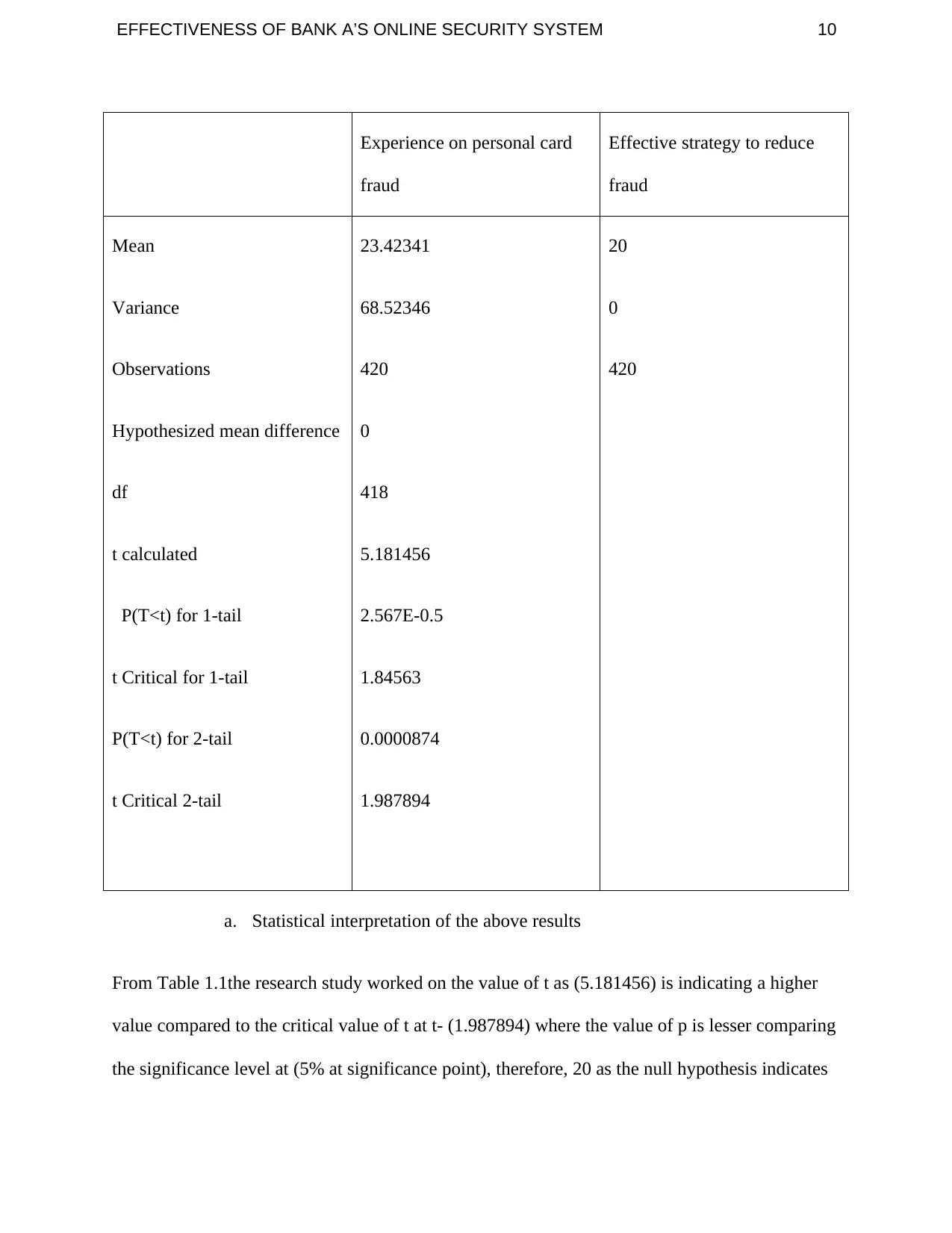
Experience on personal card
fraud
Effective strategy to reduce
fraud
Mean
Variance
Observations
Hypothesized mean difference
df
t calculated
P(T<t) for 1-tail
t Critical for 1-tail
P(T<t) for 2-tail
t Critical 2-tail
23.42341
68.52346
420
0
418
5.181456
2.567E-0.5
1.84563
0.0000874
1.987894
20
0
420
a. Statistical interpretation of the above results
From Table 1.1the research study worked on the value of t as (5.181456) is indicating a higher
value compared to the critical value of t at t- (1.987894) where the value of p is lesser comparing
the significance level at (5% at significance point), therefore, 20 as the null hypothesis indicates
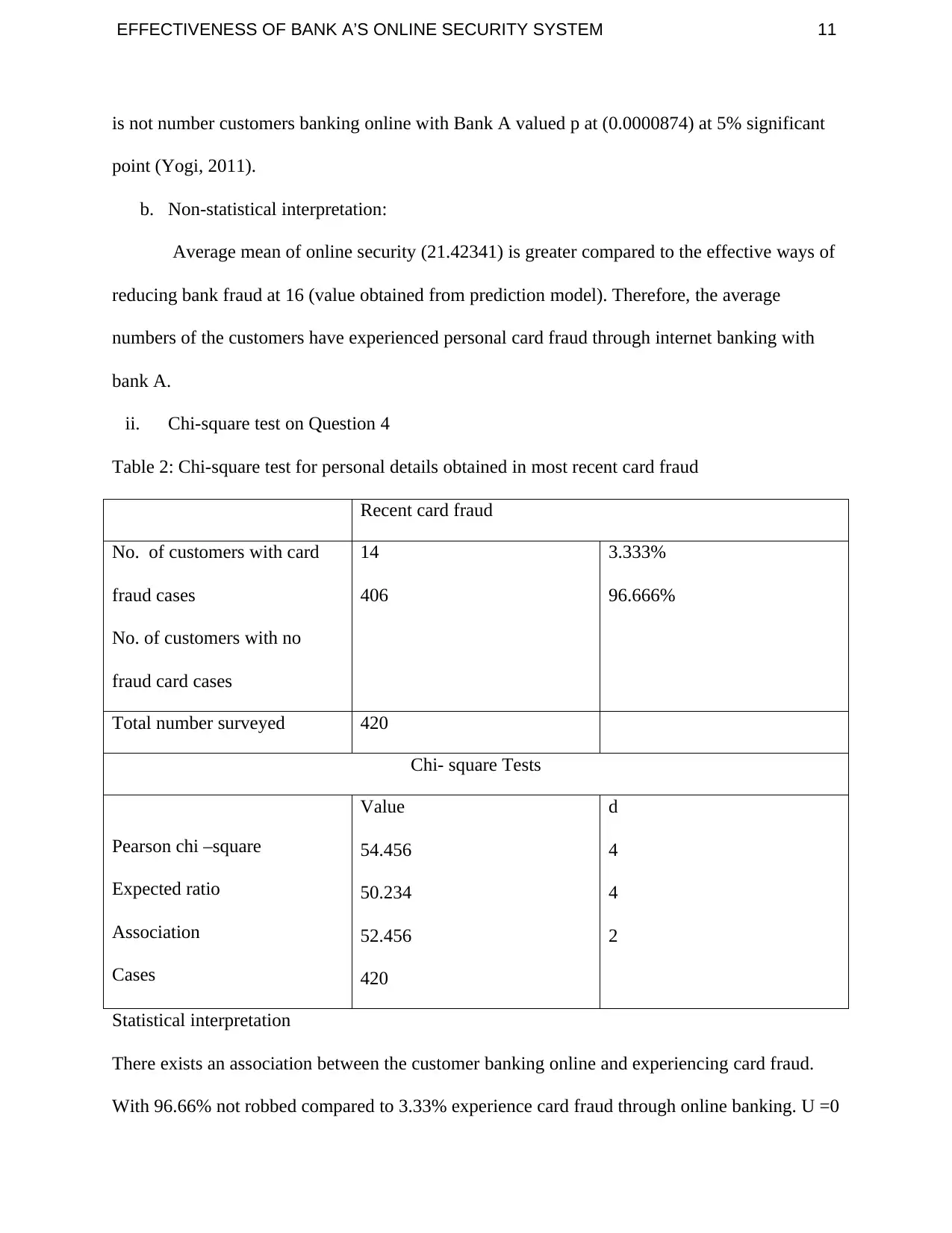
is not number customers banking online with Bank A valued p at (0.0000874) at 5% significant
point (Yogi, 2011).
b. Non-statistical interpretation:
Average mean of online security (21.42341) is greater compared to the effective ways of
reducing bank fraud at 16 (value obtained from prediction model). Therefore, the average
numbers of the customers have experienced personal card fraud through internet banking with
bank A.
ii. Chi-square test on Question 4
Table 2: Chi-square test for personal details obtained in most recent card fraud
Recent card fraud
No. of customers with card
fraud cases
No. of customers with no
fraud card cases
14
406
3.333%
96.666%
Total number surveyed 420
Chi- square Tests
Pearson chi –square
Expected ratio
Association
Cases
Value
54.456
50.234
52.456
420
d
4
4
2
Statistical interpretation
There exists an association between the customer banking online and experiencing card fraud.
With 96.66% not robbed compared to 3.33% experience card fraud through online banking. U =0
⊘ This is a preview!⊘
Do you want full access?
Subscribe today to unlock all pages.

Trusted by 1+ million students worldwide
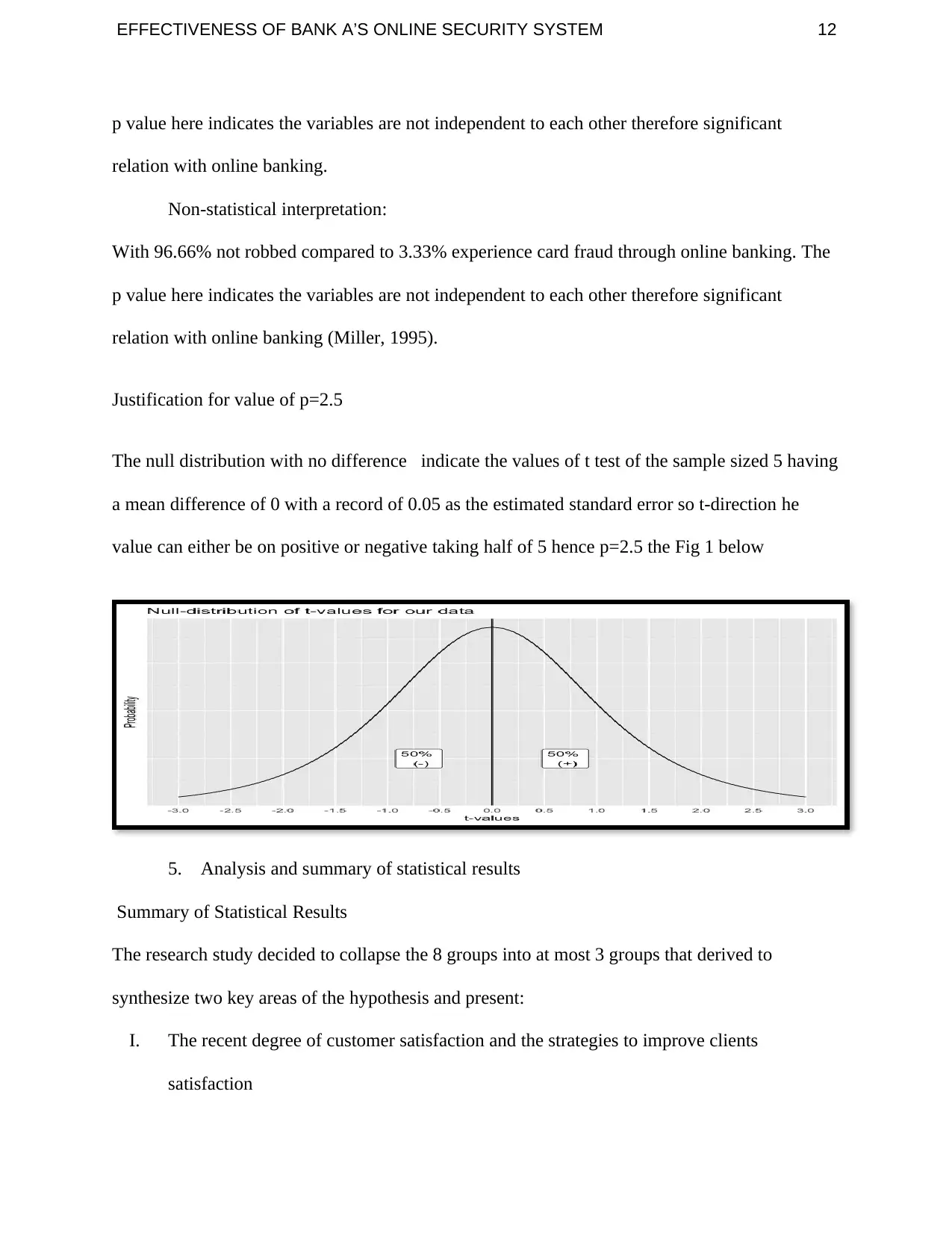
p value here indicates the variables are not independent to each other therefore significant
relation with online banking.
Non-statistical interpretation:
With 96.66% not robbed compared to 3.33% experience card fraud through online banking. The
p value here indicates the variables are not independent to each other therefore significant
relation with online banking (Miller, 1995).
Justification for value of p=2.5
The null distribution with no difference indicate the values of t test of the sample sized 5 having
a mean difference of 0 with a record of 0.05 as the estimated standard error so t-direction he
value can either be on positive or negative taking half of 5 hence p=2.5 the Fig 1 below
5. Analysis and summary of statistical results
Summary of Statistical Results
The research study decided to collapse the 8 groups into at most 3 groups that derived to
synthesize two key areas of the hypothesis and present:
I. The recent degree of customer satisfaction and the strategies to improve clients
satisfaction
Paraphrase This Document
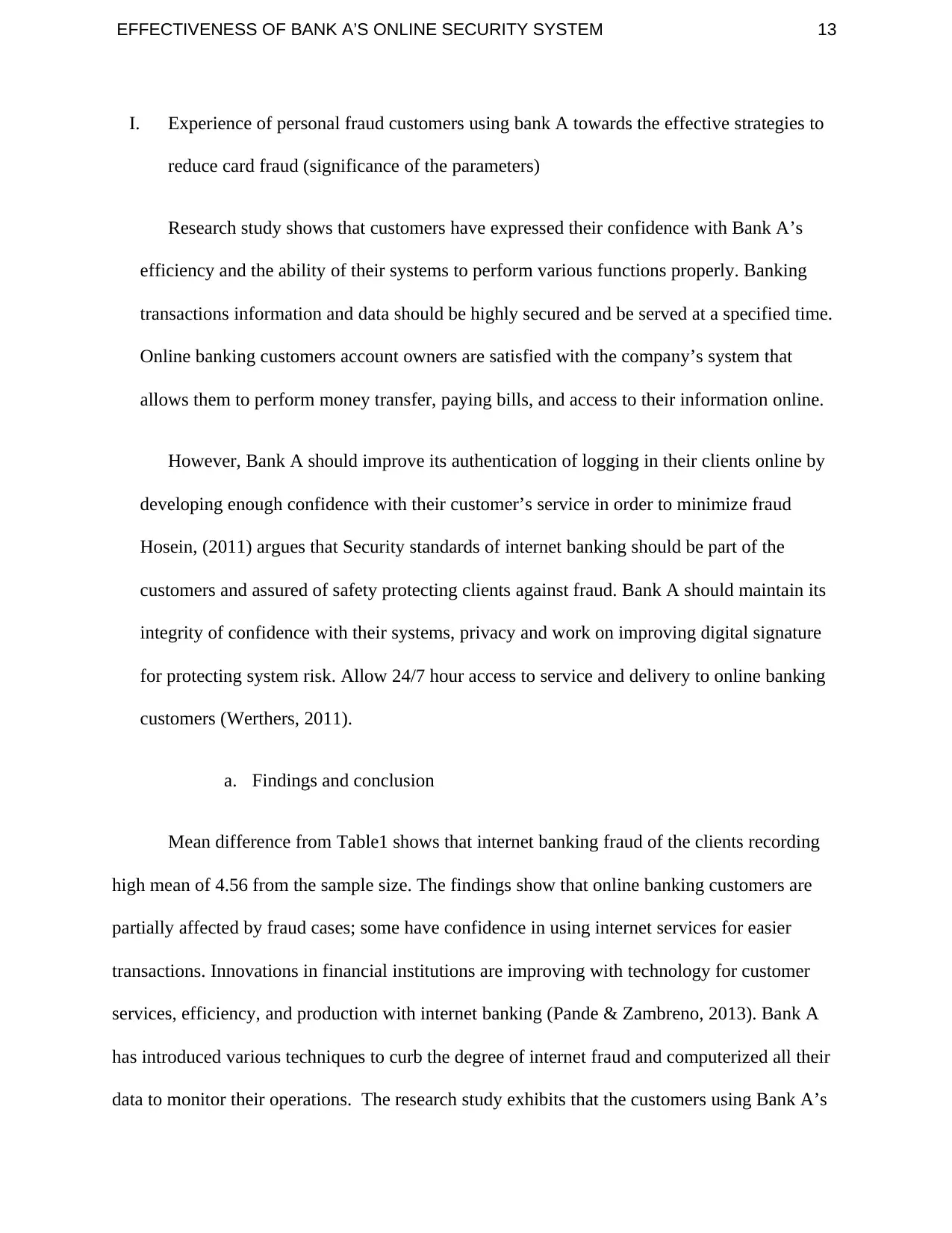
I. Experience of personal fraud customers using bank A towards the effective strategies to
reduce card fraud (significance of the parameters)
Research study shows that customers have expressed their confidence with Bank A’s
efficiency and the ability of their systems to perform various functions properly. Banking
transactions information and data should be highly secured and be served at a specified time.
Online banking customers account owners are satisfied with the company’s system that
allows them to perform money transfer, paying bills, and access to their information online.
However, Bank A should improve its authentication of logging in their clients online by
developing enough confidence with their customer’s service in order to minimize fraud
Hosein, (2011) argues that Security standards of internet banking should be part of the
customers and assured of safety protecting clients against fraud. Bank A should maintain its
integrity of confidence with their systems, privacy and work on improving digital signature
for protecting system risk. Allow 24/7 hour access to service and delivery to online banking
customers (Werthers, 2011).
a. Findings and conclusion
Mean difference from Table1 shows that internet banking fraud of the clients recording
high mean of 4.56 from the sample size. The findings show that online banking customers are
partially affected by fraud cases; some have confidence in using internet services for easier
transactions. Innovations in financial institutions are improving with technology for customer
services, efficiency, and production with internet banking (Pande & Zambreno, 2013). Bank A
has introduced various techniques to curb the degree of internet fraud and computerized all their
data to monitor their operations. The research study exhibits that the customers using Bank A’s
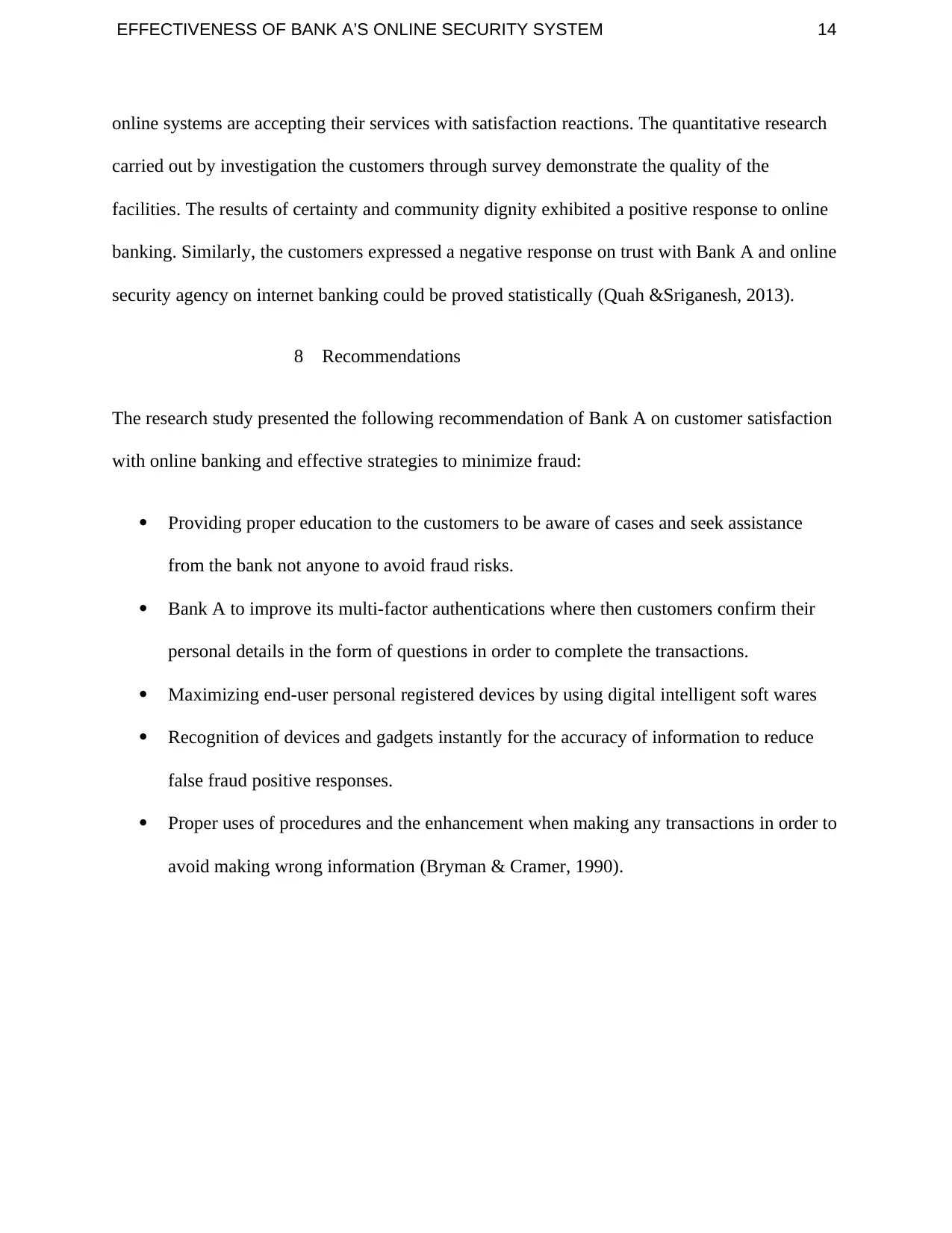
online systems are accepting their services with satisfaction reactions. The quantitative research
carried out by investigation the customers through survey demonstrate the quality of the
facilities. The results of certainty and community dignity exhibited a positive response to online
banking. Similarly, the customers expressed a negative response on trust with Bank A and online
security agency on internet banking could be proved statistically (Quah &Sriganesh, 2013).
8 Recommendations
The research study presented the following recommendation of Bank A on customer satisfaction
with online banking and effective strategies to minimize fraud:
Providing proper education to the customers to be aware of cases and seek assistance
from the bank not anyone to avoid fraud risks.
Bank A to improve its multi-factor authentications where then customers confirm their
personal details in the form of questions in order to complete the transactions.
Maximizing end-user personal registered devices by using digital intelligent soft wares
Recognition of devices and gadgets instantly for the accuracy of information to reduce
false fraud positive responses.
Proper uses of procedures and the enhancement when making any transactions in order to
avoid making wrong information (Bryman & Cramer, 1990).
⊘ This is a preview!⊘
Do you want full access?
Subscribe today to unlock all pages.

Trusted by 1+ million students worldwide
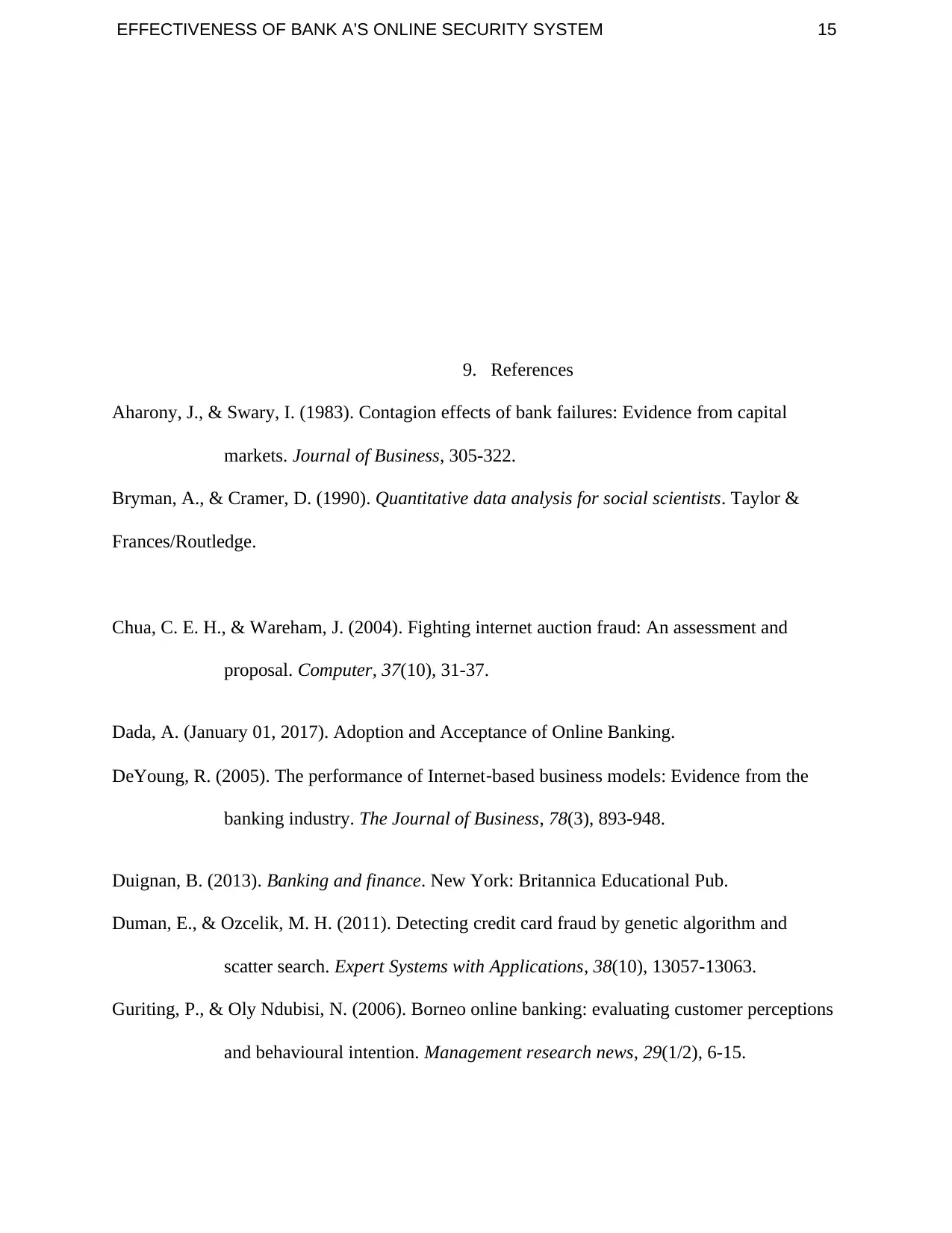
9. References
Aharony, J., & Swary, I. (1983). Contagion effects of bank failures: Evidence from capital
markets. Journal of Business, 305-322.
Bryman, A., & Cramer, D. (1990). Quantitative data analysis for social scientists. Taylor &
Frances/Routledge.
Chua, C. E. H., & Wareham, J. (2004). Fighting internet auction fraud: An assessment and
proposal. Computer, 37(10), 31-37.
Dada, A. (January 01, 2017). Adoption and Acceptance of Online Banking.
DeYoung, R. (2005). The performance of Internet‐based business models: Evidence from the
banking industry. The Journal of Business, 78(3), 893-948.
Duignan, B. (2013). Banking and finance. New York: Britannica Educational Pub.
Duman, E., & Ozcelik, M. H. (2011). Detecting credit card fraud by genetic algorithm and
scatter search. Expert Systems with Applications, 38(10), 13057-13063.
Guriting, P., & Oly Ndubisi, N. (2006). Borneo online banking: evaluating customer perceptions
and behavioural intention. Management research news, 29(1/2), 6-15.
Paraphrase This Document
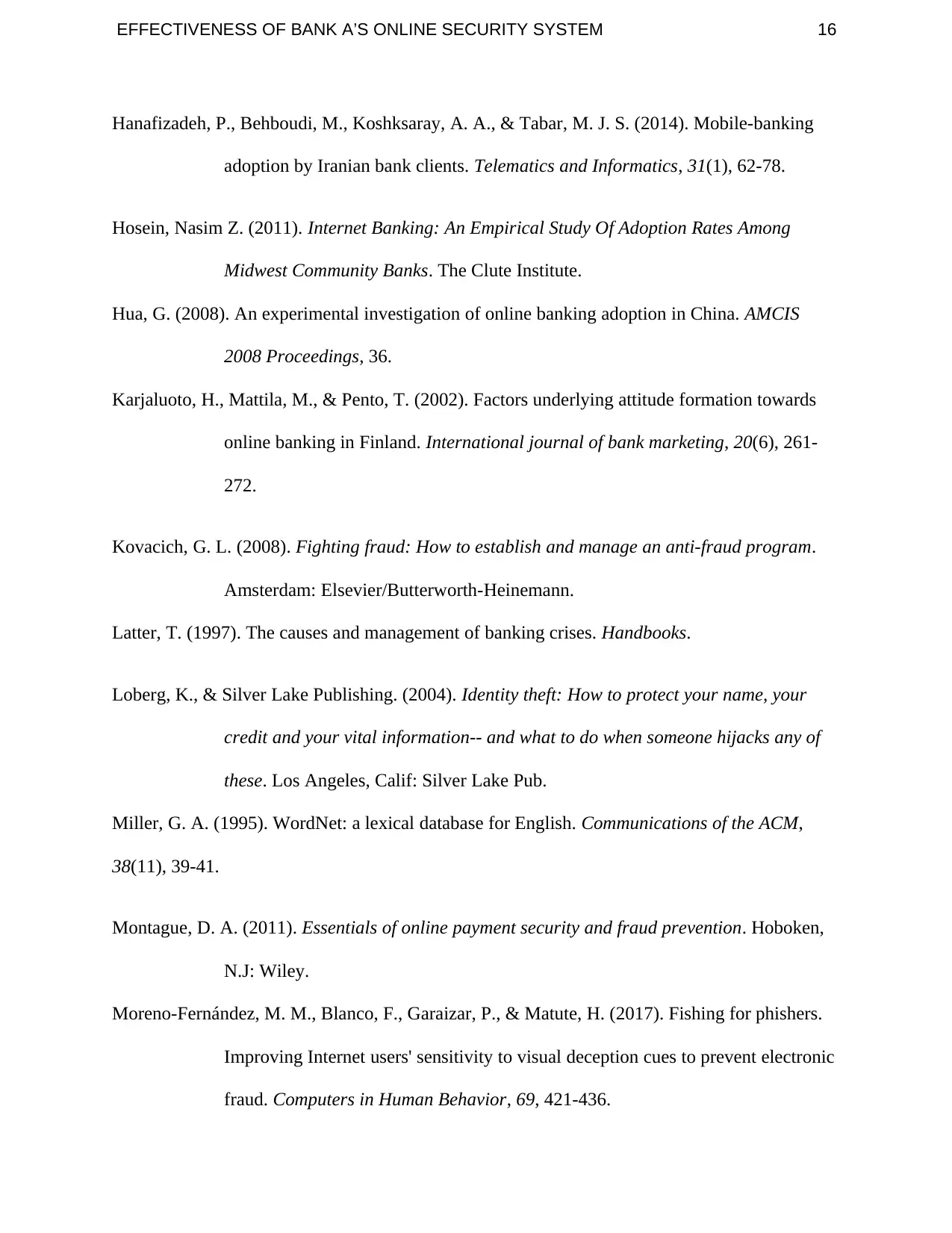
Hanafizadeh, P., Behboudi, M., Koshksaray, A. A., & Tabar, M. J. S. (2014). Mobile-banking
adoption by Iranian bank clients. Telematics and Informatics, 31(1), 62-78.
Hosein, Nasim Z. (2011). Internet Banking: An Empirical Study Of Adoption Rates Among
Midwest Community Banks. The Clute Institute.
Hua, G. (2008). An experimental investigation of online banking adoption in China. AMCIS
2008 Proceedings, 36.
Karjaluoto, H., Mattila, M., & Pento, T. (2002). Factors underlying attitude formation towards
online banking in Finland. International journal of bank marketing, 20(6), 261-
272.
Kovacich, G. L. (2008). Fighting fraud: How to establish and manage an anti-fraud program.
Amsterdam: Elsevier/Butterworth-Heinemann.
Latter, T. (1997). The causes and management of banking crises. Handbooks.
Loberg, K., & Silver Lake Publishing. (2004). Identity theft: How to protect your name, your
credit and your vital information-- and what to do when someone hijacks any of
these. Los Angeles, Calif: Silver Lake Pub.
Miller, G. A. (1995). WordNet: a lexical database for English. Communications of the ACM,
38(11), 39-41.
Montague, D. A. (2011). Essentials of online payment security and fraud prevention. Hoboken,
N.J: Wiley.
Moreno-Fernández, M. M., Blanco, F., Garaizar, P., & Matute, H. (2017). Fishing for phishers.
Improving Internet users' sensitivity to visual deception cues to prevent electronic
fraud. Computers in Human Behavior, 69, 421-436.
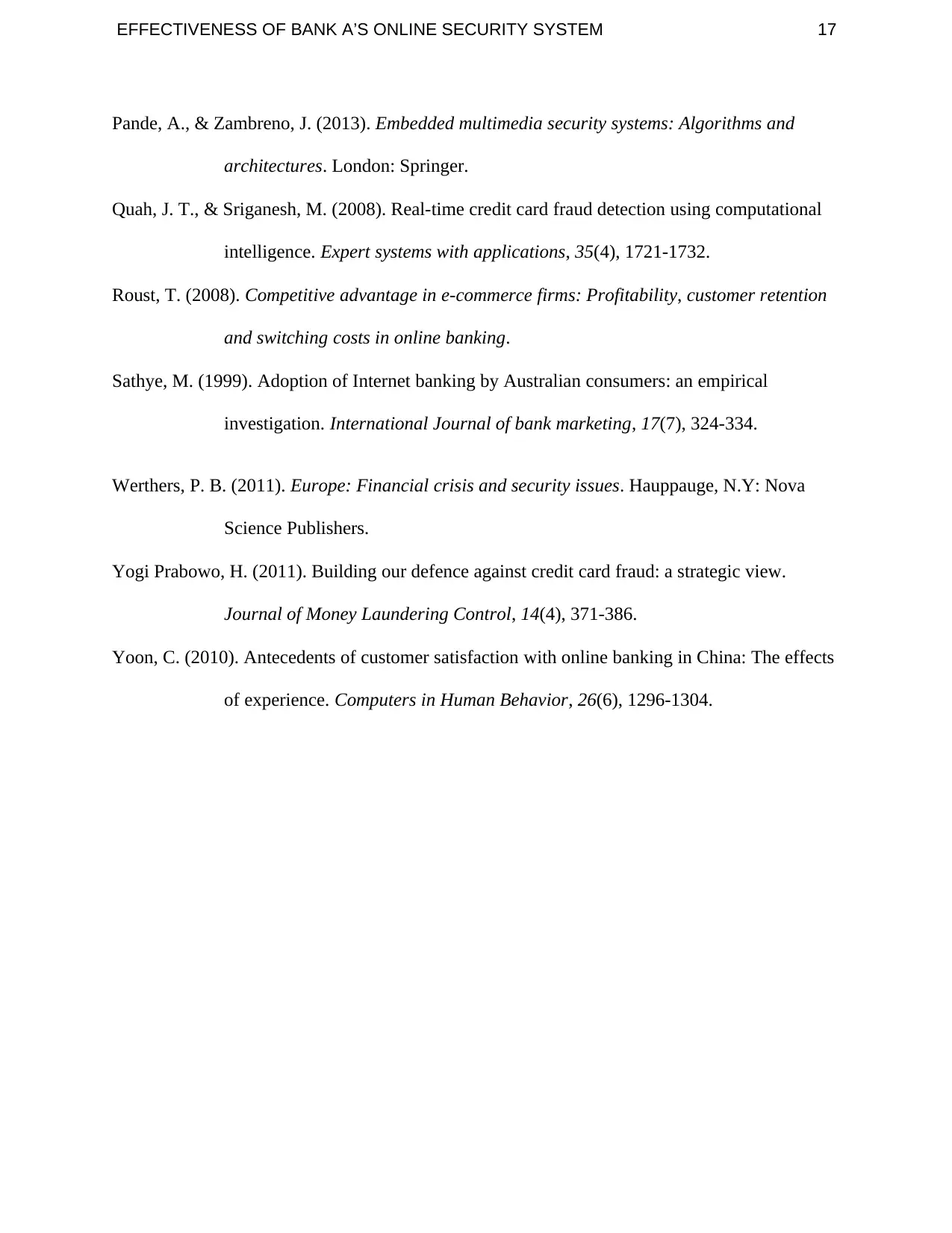
Pande, A., & Zambreno, J. (2013). Embedded multimedia security systems: Algorithms and
architectures. London: Springer.
Quah, J. T., & Sriganesh, M. (2008). Real-time credit card fraud detection using computational
intelligence. Expert systems with applications, 35(4), 1721-1732.
Roust, T. (2008). Competitive advantage in e-commerce firms: Profitability, customer retention
and switching costs in online banking.
Sathye, M. (1999). Adoption of Internet banking by Australian consumers: an empirical
investigation. International Journal of bank marketing, 17(7), 324-334.
Werthers, P. B. (2011). Europe: Financial crisis and security issues. Hauppauge, N.Y: Nova
Science Publishers.
Yogi Prabowo, H. (2011). Building our defence against credit card fraud: a strategic view.
Journal of Money Laundering Control, 14(4), 371-386.
Yoon, C. (2010). Antecedents of customer satisfaction with online banking in China: The effects
of experience. Computers in Human Behavior, 26(6), 1296-1304.
⊘ This is a preview!⊘
Do you want full access?
Subscribe today to unlock all pages.

Trusted by 1+ million students worldwide
Related Documents
Your All-in-One AI-Powered Toolkit for Academic Success.
+13062052269
info@desklib.com
Available 24*7 on WhatsApp / Email
![[object Object]](/_next/static/media/star-bottom.7253800d.svg)
© 2024 | Zucol Services PVT LTD | All rights reserved.





